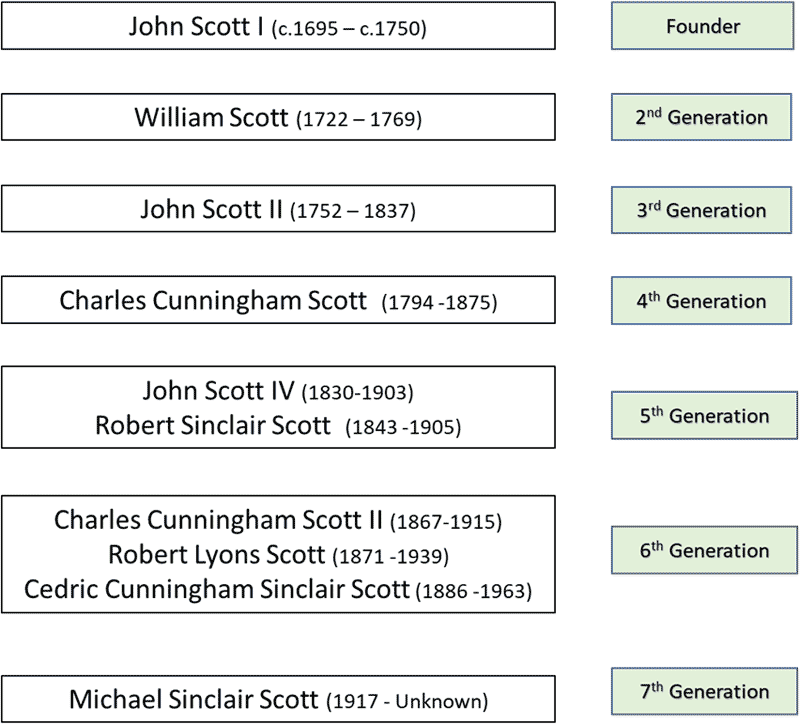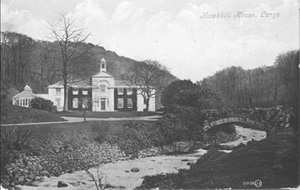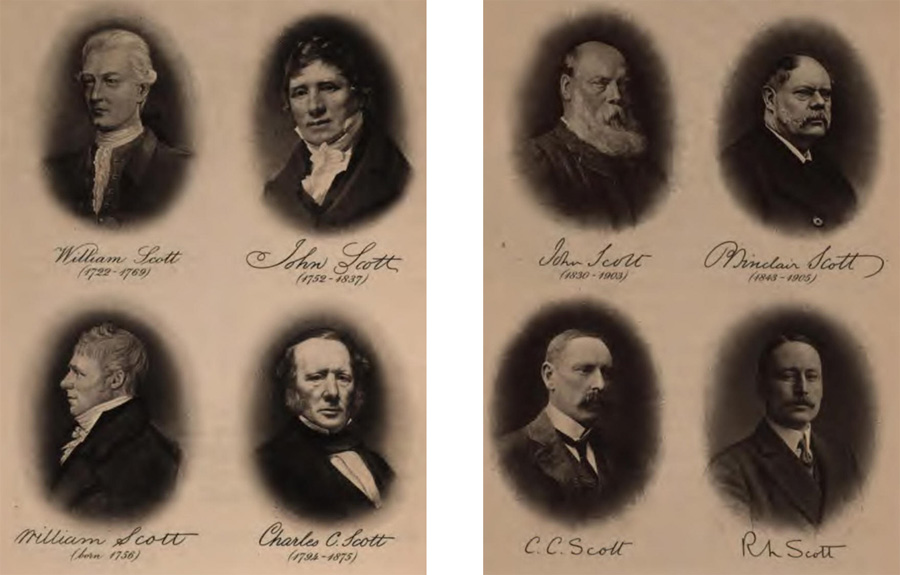A brief history of Scotts Shipbuilding company
The information in this article has been extracted and summarised from the following sources:
- A history of Scotts found on the website ElectricScotland.com
- A history of Scotts of Greenock found on inverclydeshipbuilding.com
- Scotts Shipbuilding and Engineering Company found on Wikipedia
The Scotts Shipbuilding Dynasty

JOHN SCOTT I, founded the Scott’s shipbuilding yard in 1711 to build small fishing craft and coasting boats. Note: In Greenock in 1728, there was as many as nine hundred fishing boats, locally built, each carrying between 20 – 24 nets and manned by a crew of four. Over John’s tenure, the fishing vessels got larger as fishing moved further offshore, and the firm also became involved in building ships for the burgeoning whaling trade. [1]
The business passed to John’s son, WILLIAM SCOTT (1722 – 1769), who led the yard through the middle of the eighteenth century until around 1773. During this time Scott’s prospered and the ships continued to grow in both length and tonnage. William also invested in land to build a yard on the shore of the West Burn and constructed a graving/dry dock. [1]

Source: University of St Andrews Libraries & Museums
Between the period 1773 and 1829, the firm was headed by the second JOHN SCOTT II (1752 – 1837), son of William, who continued to grow the company and its reputation as well as meet the demands for ever larger vessels. In 1791, the yard launched the 600 tons Brunswick and in 1794 the 650 tons Caledonia – each the largest ship in Scotland of its respective year. The yard expanded into the construction of ships for the West Indian and Indo-china trade (the latter after 1815) as well as sailing and steam yachts for ‘home market’ customers. To manage this growth, John purchased three large plots of land in 1787, 1788 and 1789 which extended the yard almost from the West Quay to the West Burn. But John’s focus wasn’t just on the business, he built Custom House Quay in 1791, he played a large part in developing the banking facilities of the town and in 1815 bought Hawkshill/Halkshill in Largs which became the family home for many years to come. [1]
John Scott II’s son, CHARLES CUNNINGHAM SCOTT (1794 -1875), together with his elder brother, JOHN SCOTT III (1785 -1874) carried on the business as “John Scott and Sons” developing still further the progressive policies set by their father. However, it was Charles Cunningham Scott together with his eldest son, JOHN SCOTT IV, pictured below, who created the Cartsdyke Yard as Scott & Company in 1850, and it’s this firm which has maintained the continuity of the Scotts association with shipbuilding. [1]

In due course JOHN SCOTT IV (1830 – 1903) mentioned above together with his brother ROBERT SINCLAIR SCOTT (1843 – 1905), took over the reins of the firm. They completely restructured the Cartsdyke yard and then acquired the iron shipbuilding yard and graving dock from Robert Steele and Sons in 1883, on which they established the Cartsburn dockyard, specialising in naval construction. [1]
During the brothers’ time, the firm was also heavily involved in the design and construction of steamships for overseas voyages; in improving the economy of the steam engine through the development of high steam pressures and of multiple expansion; and in naval work, and its advancement. [1]
In 1899 Scott & Co was incorporated as a limited company, Scotts Shipbuilding & Engineering Co. Ltd. In 1904, the company absorbed the family engineering works in Greenock and the following year, the yard completed their last four masted barque – Archibald Russell. [1]
Next to take lead the firm as well as become its chairman was CHARLES CUNNINGHAM SCOTT II (1867 – 1915), son of John Scott IV. His brother ROBERT LYONS SCOTT (1871 – 1939) was a board director and later succeeded Chares as chairman. With the advancement in steam and increasing worldwide tensions, Scotts became heavily involved in naval work, completing their first dreadnought battleship, Colossus, for the royal Navy in 1909 and followed her with Ajax in 1912. In parallel they became involved in building submarines, constructing S1, S2 and S3 in the yard as well as the motor driven subs E31, E51 – fitted with minelaying capability. [1]
Scotts were helped during the depression by warship orders and whilst work was still slack in 1934 the opportunity was taken to exchange the company’s East Cartsdyke yard with the mid Cartsdyke yard owned by the Greenock Dockyard Co. This unique deal included all of the machinery in each yard, and placed Scotts in a much more favourable position with a continuous river frontage and an enlarged Cartsburn Dockyard. [1][2]
The Cartsburn Dockyard was given over entirely to naval construction during WWII, building three cruisers, twenty destroyers and twelve subs. In May 1941 the Head Office was destroyed by bombing, losing all the valuable ship and engineering records. The engine and boiler works suffered a direct hit and were out of action for six months. [2]
The shipyard was switched back to merchant construction at the end of the war largely for the Blue Funnel Line, Elder, Dempster and Swire.[2]
It’s not clear from the records, who led Scotts in these key years 1939 to 1957, possibly Cedric C Sinclair Scott, but in 1957 MICHAEL SCOTT (1917), grandson of Robert Sinclair Scott and son of Cedric C Sinclair Scott was appointed as chairman. [2]
His first priority was to modernise the yard to allow construction of tankers and bulk carriers up to 40,000 dwt. A crane pier was laid down the middle of the yard and two 60ton cranes installed, and on the west of this pier a reinforced concreted berth was laid, which could either build one ship of 40,000dwt or two ships of around 19,000dwt. On the east side of the crane pier, ships of up to 24000 dwt could be built, with a smaller berth for warships to the east of the main berths. Submarines continued to be built in the yard until 1975 – the last being the Otama. [2]
In 1965, Michael Scott, announced the takeover of Scott & Sons (Bowling) as well as a merger with the Greenock Dockyard Company enabling the Cartsburn and Cartsdyke shipyards to be fully integrated. In 1967, the Company merged with Lithgows to form Scott Lithgow Ltd, operating as Scotts Shipbuilding Co (1969) Ltd. Scott Lithgow Ltd was absorbed into the nationalised British Shipbuilders in 1977 at which point Michael, the last of the Scotts retired. [3]
Cartsdyke Shipyard was closed in 1979 and Cartsburn in 1984. In 1983, the Scott Lithgow company and yards were sold to Trafalgar House. No further shipbuilding was undertaken and the 270-year-old Scott shipbuilding company finally ceased trading in 1993. Between 1988 and 1997, the Cartsburn and Cartsdyke shipyards were gradually demolished and redeveloped as insurance offices, computer warehouses and fast-food restaurants. [3]
Sources:
[1] https://electricscotland.com/history/transport/scotts1.htm
[2] https://www.inverclydeshipbuilding.com/scotts-of-greenock
[3] https://en.wikipedia.org/wiki/Scotts_Shipbuilding_and_Engineering_Company
